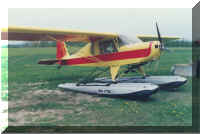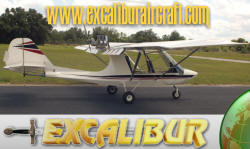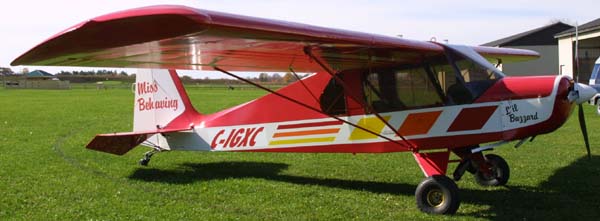|
The L'il Buzzard was first
introduced in 1990. The original design was a compilation of a
number of "need to have" items, found on a variety of ultralight
trainers on the market at that time.
There were a several reasons for the design and
introduction of the L'il Buzzard. The first was cost, the second
was durability, and the third  building times and ease of
maintenance. Dave Loveman has been serving the ultralight aviation
community since 1978, first as a source of information on Rotax
engines and repairs and as an ultralight flight instructor. building times and ease of
maintenance. Dave Loveman has been serving the ultralight aviation
community since 1978, first as a source of information on Rotax
engines and repairs and as an ultralight flight instructor.
During that
time a number of craft have been used for flight training. These include the Quicksilver MX,
Rotec Rally, Skyseeker, Quad City Challenger, Beaver, ,
Bushmaster, Avid Flyer, Rans, CGS Hawk,
Chinook, Buccaneer, Carrera, Explorer, Zephyr, Merlin, Kitfox, and Sea Rey.
While most of these craft were or are still excellent aircraft for private ultralight pilots and owners, they all fell
short in a number of areas when used as ultralight flight
trainers. Specific areas of concern were landing gear, control
systems, Canadian pilot comfort, ease of repair and
performance.
| Working closely with a fellow ultralight pilot
and builder Ted Van Erp of London Ontario, an aircraft was
designed based on the conventional "Cub design"
only in a side by side seating configuration.
To better fit the training environment adjustable seats
were used so that pilots of different sizes could be seated
comfortably. The original L'il Buzzard was widened from 38
inches to 41 inches, when it was found that two pilots, with
winter clothing were "snug" in the cabin. |
 |
| It was decided that dual controls were
favoured over a center mounted stick. This gives the student a
complete sense of control while flying, and yet
allows the instructor to "fly along and feel what the student
is doing."
To add to student pilot comfort an adjustable left hand
stick was added, to accommodate for different arms lengths and
seating positions. |
 |
| Three throttle controls let students fly
using a left hand stick and right hand throttle arrangement,
or a right stick and left hand throttle. This allows
training of pilots owning and flying other aircraft such as the Kitfox which has a center throttle, and left stick or a
Buccaneer SX which is left hand throttle and right stick. The
three throttles are connected under the dash to a throttle
control linkage, pilots can remove any two of the three
throttles if desired. |
 |
| |
|
| An in cabin trim located in the center section
of the upper cabin area was introduced when it was found that
continuous pilot input on long distance flights contributed to
fatigue.
An adjustable horizontal stabilizer was added and the
fuselage lengthened, to allow the use of the 912 series of
engines. |
 |
With the introduction of the 582 and 912
engines the engine cowl was changed so that the cowl
"gull wing doors" were offset to allow changing spark plugs, checking the
radiator and fluid levels without having to remove the front
cowl. The cowl was also designed so that pilot's could work on
the underside of the engine and exhaust without having to
remove it. having to remove the front
cowl. The cowl was also designed so that pilot's could work on
the underside of the engine and exhaust without having to
remove it.
At the same time an adjustable radiator kit was introduced
to allow the raising or lowering of the radiator, by use of a
simple hand crank located between the control sticks.
Pilot's can control the engine coolant
temperature on hot or cold days. Raising the rad increases the
engine temperature, while lowering it cools the engine.
This proved to be an added advantage when a cabin heater
was installed. The additional cooling supplied by the heater
lowered the engine temperature - but with the adjustable
radiator system the pilot can "dial in" the engine temperature
for optimum comfort and performance.
|
 I I t
was decided that wing tanks would be used eliminating the
spillage of fuel into the cabin area, or gas venting into the
cabin. t
was decided that wing tanks would be used eliminating the
spillage of fuel into the cabin area, or gas venting into the
cabin.
The use of wing tanks also allowed for the installation of
a very simple site fuel gauge.
To ease filling the fuel tanks, a step was added to the
landing gear, letting the pilot support himself when
filling the tanks.
|
 In 1997 an additional lifting support was
added to the rear of the plane so that the pilot can lift the
tail from either side of the craft to move it around or two
people, a student and instructor can both lift. In 1997 an additional lifting support was
added to the rear of the plane so that the pilot can lift the
tail from either side of the craft to move it around or two
people, a student and instructor can both lift.
|
  A handle was
also added to the rudder to allow for the pulling of the plane
back into it's hangar or parking spot. Tie down rings were
also welded into the front struts, and a lifting ring added
above the cabin. A handle was
also added to the rudder to allow for the pulling of the plane
back into it's hangar or parking spot. Tie down rings were
also welded into the front struts, and a lifting ring added
above the cabin.
With the ring the L'il Buzzard can be lifted on it's C of G for installation of floats or repairs. |

To
keep costs down and simplify float installation the L'il Buzzard
uses it's main landing gear for the front float mount, and
comes with rear mounting brackets welded into the fuselage.
Once installed the floats take only 10 minutes to remove or
re-install.
|
 
The L'il Buzzard has two storage areas behind the seat. The
first area directly behind the seats has been used to store
two full five gallon cans of fuel for a 1200 mile cross country
trip.The second area allowed for the storing of a sleeping
bag, tent, tie downs, tool kit and supplies for the trip.
|
| Over 80 % of the L'il Buzzard is
straight 4130 chromoly steel tubing. This includes the
struts, jury struts, and aileron control system linkages
push pull tubes, which are located out in the open for
inspection, repair, and maintenance. The rudder and elevator
cables are conventional aircraft size. The wing uses
aircraft grade aluminum D cell construction with, aluminum
spars and ribs - NO FOAM or WOOD is used in the L'il Buzzard structural fuselage or
wings. The fuel tanks are also metal. The wing tips and
engine cowl are fiberglass with aluminum gull wing doors.
or WOOD is used in the L'il Buzzard structural fuselage or
wings. The fuel tanks are also metal. The wing tips and
engine cowl are fiberglass with aluminum gull wing doors.
The landing gear bungees are the same used on a
conventional "CUB." The radiator used with the Rotax series of
engines is from a Volkswagen. The windshield and doors are
just a flat piece of lexan which takes it shape when bolted to
the airframe.
When installing a Rotax engine NOTHING needs to be changed
on the engine it bolts directly to the motor mount. The only
welding that needs to be done is to fasten the muffler
attachment brackets and spring hooks to the exhaust system.
The L'il Buzzard comes built ready to be painted. The
doors, windshield, and rear tear drop windows are already
installed. The fuselage and wings are completely built and
covered ready to be primed. The control system, control tubes,
control cables are already installed.
If you are doing you own engine installation the front cowl
is supplied but not drilled. The owner drills it after
installing the engine. |
|












 A handle was
also added to the rudder to allow for the pulling of the plane
back into it's hangar or parking spot. Tie down rings were
also welded into the front struts, and a lifting ring added
above the cabin.
A handle was
also added to the rudder to allow for the pulling of the plane
back into it's hangar or parking spot. Tie down rings were
also welded into the front struts, and a lifting ring added
above the cabin.



